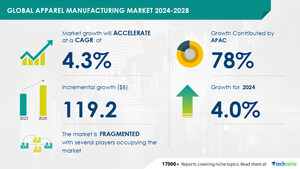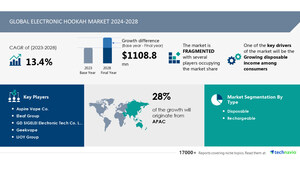NEW YORK, May 14, 2024 /PRNewswire/ -- The global printed electronics market size is estimated to grow by USD 47.58 bn from 2023-2027, according to Technavio. The market is estimated to grow at a CAGR of 15% during the forecast period.
For more insights on the forecast market size and historic data (2017 - 2021) - Download Free sample report in a minutes
Forecast period |
2023-2027 |
Base Year |
2022 |
Historic Data |
2017 - 2021 |
Segment Covered |
Technology (Screen, Inkjet, Gravure, and Flexographic), Application (Display, Sensors, Photovoltaics, Battery, and Others), and Geography (APAC, North America, Europe, Middle East and Africa, and South America) |
Region Covered |
APAC, North America, Europe, Middle East and Africa, and South America |
Key companies profiled |
Agfa Gevaert NV, BASF SE, DuPont de Nemours Inc., Dycotec Materials Ltd., Enfucell, Fujikura Co. Ltd., Henkel AG and Co. KGaA, InnovationLab GmbH, Jabil Inc., Koch Industries Inc., Nissha Co. Ltd., NovaCentrix, Optomec Inc., Printed Electronics Ltd., Samsung Electronics Co. Ltd., Schreiner Group GmbH and Co. KG, TE Connectivity Ltd., Xerox Holdings Corp., YFY Inc., and Ynvisible Interactive Inc. |
Key Market Trends Fueling Growth
- A notable trend in technology is the emergence of stretchable electronics, also termed elastic electronics, which involve the fabrication of electronic circuits capable of stretching and deforming.
- These circuits can either be placed on stretchable substrates or integrated into flexible materials such as silicones or polyurethanes.
- The adoption of stretchable electronics is poised to unlock a myriad of innovative applications, spanning from cyber skin for robotic devices to flexible implantable electronics and stretchable energy storage solutions.
- Additionally, stretchable electronics hold promise for applications like blood glucose test strips, showcasing their potential to revolutionize diverse sectors.
- The healthcare sector is expected to spearhead the growth of the stretchable electronics market, driven by the escalating demand for real-time monitoring in critical patient care contexts, alongside health tracking requirements in military and sports environments.
Market Challenges
- A significant obstacle impacting market penetration is the issue surrounding encapsulation.
- The encapsulation process poses a substantial challenge in the manufacturing of flexible OLED displays and light panels due to its complexity and high cost.
- This challenge is prevalent across both flexible and rigid substrates, resulting in elevated manufacturing expenses as production volumes increase.
- Leading companies such as SAMSUNG and LG Display, employing vapor deposition techniques, grapple with the considerable expense associated with curved OLED displays.
- Similarly, the cost burden of encapsulation is anticipated to persist for printed OLED displays, with costs likely to mirror those of vapor deposition.
- Initially, glass substrates are expected to dominate the landscape of OLED display manufacturing, serving as the primary substrate material.
Research report provides comprehensive data on impact of trend, driver and challenges - Buy Report
Segment Overview
This printed electronics market report extensively covers market segmentation by
- Technology
- 1.1 Screen
- 1.2 Inkjet
- 1.3 Gravure
- 1.4 Flexographic
- Application
- 2.1 Display
- 2.2 Sensors
- 2.3 Photovoltaics
- 2.4 Battery
- 2.5 Others
- Geography
- 3.1 APAC
- 3.2 North America
- 3.3 Europe
- 3.4 Middle East and Africa
- 3.5 South America
1.1 Screen- The printed electronics market encompasses various technologies, including Gravure, Flexographic, and Screen printing. Gravure and Offset printing are ideal for producing large-area prints with high precision and accuracy, making them popular choices for smart packaging applications. In contrast, Screen printing technology, with its high throughput and low cost per unit, is widely used for large-volume production in the consumer electronics sector. The Inks segment, a crucial component of printed electronics, includes conductive inks such as Silver, Carbon, Metallic, and emerging Graphene ink. R2R printing, a Roll-to-Roll process, is gaining traction due to its lower production cost and higher efficiency. Technologies like CymMetrik focus on improving materials, inks, and substrates, including Flexible substrates like glass, Silicon, Flexible foil, Paper, and Polyethylene Terephthalate (PET). Inkjet printing is another promising technology, offering low power consumption and ease of upgrades and improvisations. The market caters to various printed electronics applications, including OLED displays, Printed RFID devices, and IoT devices, transforming consumer electronics, IoT devices, smartphones, and display devices into intelligent communication devices.
For more information on market segmentation with geographical analysis including forecast (2023-2027) and historic data (2017 - 2021) - Download a Sample Report
Research Analysis
The Printed Electronics Market is a dynamic and innovative research arena in the consumer electronics industry. This market encompasses various applications, including IoT devices, smartphones, and communication devices. Key technologies driving this market are OLED displays, Printed RFID devices, and advanced materials such as Ink materials segment and Substrate material segment. Flexible substrates, like flexible foil, paper, and Polyethylene Terephthalate (PET), are increasingly used due to their lower production cost, higher efficiency, and low power consumption. Technologies like Inkjet printing and screen-printing are popular for their ability to produce complex designs on various substrates, such as glass, silicon, and flexible foil. Companies in this sector, like CymMetrik, are continually upgrading and improving their materials, inks, and substrates to meet the evolving demands of the consumer electronics industry.
Market Research Overview
The Printed Electronics Market is experiencing significant growth due to the development of flexible, lightweight, and cost-effective electronic devices. Devices such as sensors, displays, and energy harvesting systems are being produced using this technology. Old and new players in the industry are investing in research and development to improve the performance and functionality of printed electronics. The market is segmented by materials, applications, and regions. Conductive polymers, metals, and semiconductors are the key materials used in this technology. Applications include displays, sensors, energy harvesting, and RFID tags. The market is driven by the increasing demand for flexible and wearable electronics, and the growing adoption of printed electronics in various industries such as healthcare, automotive, and consumer electronics. The future of printed electronics looks promising with advancements in technology and the potential for mass production.
Table of Contents:
1 Executive Summary
2 Market Landscape
3 Market Sizing
4 Historic Market Size
5 Five Forces Analysis
6 Market Segmentation
- Technology
- Screen
- Inkjet
- Gravure
- Flexographic
- Application
- Display
- Sensors
- Photovoltaics
- Battery
- Others
- Geography
- APAC
- North America
- Europe
- Middle East And Africa
- South America
7 Customer Landscape
8 Geographic Landscape
9 Drivers, Challenges, and Trends
10 Company Landscape
11 Company Analysis
12 Appendix
About Technavio
Technavio is a leading global technology research and advisory company. Their research and analysis focuses on emerging market trends and provides actionable insights to help businesses identify market opportunities and develop effective strategies to optimize their market positions.
With over 500 specialized analysts, Technavio's report library consists of more than 17,000 reports and counting, covering 800 technologies, spanning across 50 countries. Their client base consists of enterprises of all sizes, including more than 100 Fortune 500 companies. This growing client base relies on Technavio's comprehensive coverage, extensive research, and actionable market insights to identify opportunities in existing and potential markets and assess their competitive positions within changing market scenarios.
Contacts
Technavio Research
Jesse Maida
Media & Marketing Executive
US: +1 844 364 1100
UK: +44 203 893 3200
Email: [email protected]
Website: www.technavio.com/
SOURCE Technavio

WANT YOUR COMPANY'S NEWS FEATURED ON PRNEWSWIRE.COM?
Newsrooms &
Influencers
Digital Media
Outlets
Journalists
Opted In





Share this article